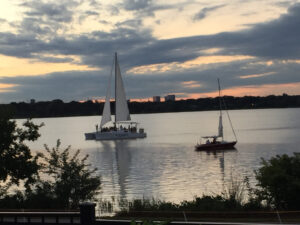There were 91 attendees at the Dredging Feasibility Study virtual meeting last week to present draft results and gain initial community input. The first 45 minutes were devoted to revisiting what’s happened up to this point. The main topic was the five alternative dredging scenarios and related cost estimates identified by the consulting engineering firm Freese & Nichols. The target lake depth for recreational use is 8 feet.

BASELINE SCENARIO – Keep doing what’s been done in the past: major dredging every 20-25 years. $50-$88 million every time.
ALTERNATIVE #1 – An initial large-scale dredging ($50-$88 million) followed by maintenance dredging every 12 years ($32-$56 million each).
ALTERNATIVE #2 – An initial large-scale dredging ($50-$88 million) followed by annual maintenance dredging ($4-6 million each).
ALTERNATIVE #3 – Annual maintenance over a period of 13 years to gradually achieve the desired 8-foot depth. The cost estimate for the first 12 years is $7-$12 million, with annual maintenance dredging starting the 13th year at a cost of $4-$6 million.
ALTERNATIVE #4 – An initial large-scale dredging ($35-$88 million) followed by smaller dredging efforts every 3 years ($7-$12 million).
They also looked at the idea of a 120-acre “forebay” to catch sediment before it washes into the lake; this is considered extremely unlikely because of the space and proximity it would require, as well as necessary permitting from the Corps of Engineers.
The audience — who primarily identified as homeowners on or near the lake, and hikers/joggers — were polled on several questions. Their responses:
Most would find annual disruptions acceptable to achieve/maintain lake depth.
Most would find up to 6 months of recreational disruptions acceptable.
Priority areas for dredging were virtually tied, with a slight edge to the sailing clubs areas.
Sustainability of the solution was considered the most important factor in determining a dredging scenario.
Alternative #2 was the preferred scenario.
Next: Funding
There are almost no grants or government loans to fund dredging of a primarily recreational body of water. City funding via bonds is the most likely solution, with possible additional funds from lake user fees and/or special tax districts.
Timeline:
It likely will be 3 years (best case) before dredging could begin. That includes 1-2 years to procure funding and complete engineering design; 2-3 years for local, state, and federal permitting, and for public review and comment.
Obstacles/concerns:
- Cost
- Finding a location for de-watering and disposal of sediment
- Environmental permitting (identified as a critical milestone); an Environmental Impact study will be conducted later.
Public questions and comments will be accepted via Google form that will be live until July 31.
For questions or concerns regarding this project, please contact Dallas Water Utilities, Project Manager, David Phan, P.E., CFM at 214-948-4682 or [email protected]
